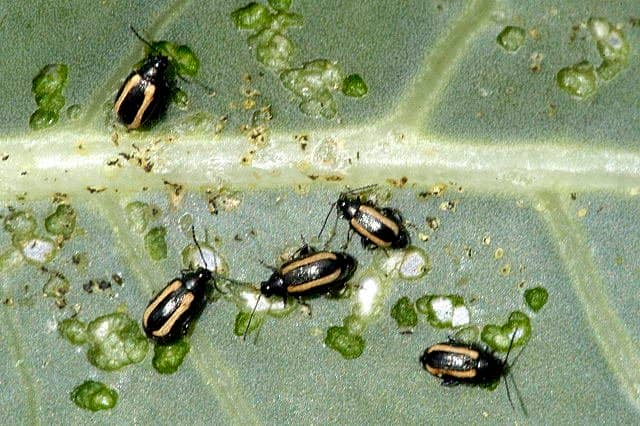How to Get Rid of Fleas on Cats With Dawn
Caren White is a Master Gardener and instructor at Home Gardeners School. She has been associated with Rutgers Gardens for over a decade.

Wikimedia Commons
Fleas in your garden? No, those are flea beetles, a variety of leaf beetle that jumps like fleas. The adults kill by spreading disease, while the larvae kill by eating the roots of your plants.
What are Flea Beetles?
Flea beetles (Phyllotreta spp) are tiny and shiny. They are about 1/10 inch long and black or tan metallic with either stripes or spots. They commonly feed on cruciferous plants such as cauliflower, cabbage and broccoli.
The adults overwinter in the soil, emerging when the temperatures reach 50°F. They are most harmful in the spring when they feed on your seedlings, killing them. Later in the season, when your plants are larger, the small holes they make in the leaves won't kill them. It's the diseases (wilt and blight) that they spread as they feed that can kill your plants.
As the adults feed, they mate and lay their eggs on the roots of your crops. When the eggs hatch, the larvae feed on those roots for 2 to 3 weeks, destroying the plants. Plants cannot grow without roots. The larvae then pupate in the soil for an additional 2 to 3 weeks, emerging as adults to start the cycle over again.

Flea beetle larva feed on plant roots
Wikimedia Commons
Delay Planting Your Garden
Fortunately, flea beetles are not terribly intelligent. You can fool them into thinking that there is nothing to eat by planting out your seedlings 2 to 3 weeks later than normal. The adults will emerge from their winter hibernation only to find a bare garden with nothing to eat. They will then move on in search of crops to which to feast and lay their eggs.
Alternatively, you can use floating row covers on your seedlings. They are "floating" because you just lay them loosely over your plants. The thin polyester material allows light and rain to get in but keeps the insects out. Make sure that the sides of the row covers are firmly anchored to the ground so that the insects can't crawl underneath. You can use pins, stones or even bury the edges in soil.
Create a Bare Perimeter Around Your Garden
A variant of the strategy of delayed planting is to aggressively weed the area around your cruciferous plants. A 3 foot strip of bare soil will discourage the flea beetles who will think there is nothing to eat and fly off in search of food elsewhere.
Read More From Dengarden
Use Companion Plants and Trap Crops
Plant herbs such as thyme or mint that have strong scents among your crops to confuse flea beetles who will think that they have accidentally stumbled upon your herb garden. since there is nothing for them to eat in an herb garden, they will fly away to find a vegetable garden to feast in.
Or you can plant a trap crop such radishes that will lure them away. Root crops such as radishes can withstand the depredations of flea beetles because their roots for which you are growing them are not affected by adult beetles.
Invite in Some Flea Beetle Enemies
Plant flowers which bloom in umbels such as fennel, dill or yarrow to attract beneficial insects such as tachnid flies and braconid wasps. These insects enjoy feeding on the pollen of the flowers. After they mate, they lay their eggs on plants that attract flea beetles because their larvae love to feast on flea beetles.
Make Your Own Spray
Combine 5 parts water with 2 parts alcohol plus a tablespoon of dish detergent and spray the foliage of your susceptible crops. The soap will help the spray to adhere to the beetles while the alcohol will dehydrate them.You will need to re-apply your spray after each rain event. This will only deter adult flea beetles. The larvae are underground feeding on the roots. Discouraging the adults from eating your crops means fewer adults in your garden and fewer larvae feeding on the roots of your plants.
Till your Garden in the Fall to Destroy Overwintering Flea Beetles
A deep tilling of your garden in the fall will prevent adult flea beetles from overwintering in your soil so that you will have fewer of them to contend with in the spring.
© 2014 Caren White
Caren White (author) on July 28, 2014:
Flourish, I'm so happy that you are learning so much! That is incredibly gratifying for me as a garden writer (and speaker). I genuinely enjoy writing about my passion for gardening. Thanks so much for reading and commenting.
FlourishAnyway from USA on July 27, 2014:
I'm learning so much about gardening and the pests that live in our gardens by reading your hubs. I guess this little guy is the dum-dum of garden insects because he's so easily fooled.
How to Get Rid of Fleas on Cats With Dawn
Source: https://dengarden.com/gardening/How-to-Rid-Your-Garden-of-Flea-Beetles